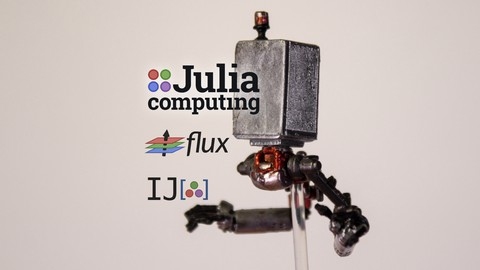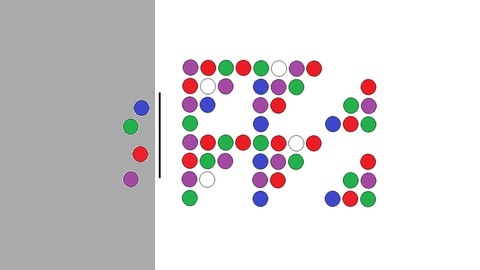Julia is a high-performance programming language designed for scientific computing, machine learning, and data analysis.
Its speed and ease of use make it a powerful tool for researchers, data scientists, and developers.
Learning Julia can open doors to exciting opportunities in fields like artificial intelligence, bioinformatics, and financial modeling.
Finding a comprehensive and engaging Julia programming course on Udemy can be a challenge, especially with the vast number of options available.
You’re looking for a course that goes beyond the basics, providing practical experience and hands-on projects to solidify your understanding.
For the best Julia programming course overall on Udemy, we recommend “Julia Programming for Data Science & Machine Learning”.
This course strikes a balance between theoretical concepts and practical applications, equipping you with the skills needed to analyze data, build machine learning models, and visualize results in Julia.
This is just the beginning of our exploration into the world of Julia programming on Udemy.
We’ve compiled a list of recommendations for different learning styles and goals, covering beginner-friendly introductions to advanced courses focused on specific applications and libraries.
Keep reading to find the perfect Julia programming course to kickstart your journey!
Programming with Julia
The course starts with an introduction to Julia, including its history and why it’s a great choice for programming.
You’ll learn how to install Julia on both Windows and Linux systems, as well as using the convenient juliaup tool.
The course then dives into the Julia REPL (read-eval-print loop) and explores various editors and IDEs suitable for Julia development.
Next, you’ll gain a solid understanding of variables, data types, and operations in Julia.
The course covers the type hierarchy, numerical data types like integers, floating-point numbers, complex numbers, and rational numbers.
You’ll also learn about character and string types, primitive and composite types, and parametric types.
Quizzes throughout the course reinforce your knowledge of these fundamental concepts.
Data structures are a crucial aspect of programming, and this course dedicates an entire chapter to them.
You’ll explore tuples, dictionaries, ranges, arrays, vectors, matrices, and multidimensional arrays.
The course also covers broadcasting and dot syntax, sets, and basic linear algebra operations.
Hands-on exercises and solutions are provided to help you practice and solidify your understanding of data structures in Julia.
Conditionals and loops are essential for controlling the flow of your programs.
The course teaches you about compound expressions, conditional evaluation, short circuit evaluation, for loops, while loops, and the use of continue and break statements.
You’ll also learn about comprehensions, a powerful feature in Julia for concisely creating arrays and dictionaries.
Functions are the building blocks of modular and reusable code.
The course covers defining functions, using higher-order functions like map, reduce, and filter, handling variable numbers of arguments, optional arguments, and keyword arguments.
You’ll also learn about composite functions and mutating functions.
Julia’s multiple dispatch and parametric methods are explored in the Methods chapter.
You’ll discover how to define function-like objects and constructors.
The course even includes a neural networks demo to showcase the power of Julia in machine learning applications.
Modules and packages are essential for organizing and sharing code.
The course teaches you how to write and use modules, leverage the Revise package for interactive development, and develop your own packages.
Metaprogramming is a powerful technique that allows you to write code that generates or manipulates other code.
The course introduces you to symbols, expressions, and writing macros in Julia.
In the Streams and Networking chapter, you’ll learn about basic input and output operations, file I/O, and working with TCP/IP connections in Julia.
Finally, the course covers parallel programming, an area where Julia excels.
You’ll explore asynchronous programming and multi-threaded programming techniques to harness the full power of modern hardware.
Julia Programming Language - From Zero to Expert
You’ll start by setting up Julia on Windows, Linux, or MacOS and configuring a Jupyter notebook environment for interactive experimentation.
The course then dives into the core language basics, covering syntax, variables, control structures, and data structures like arrays, tuples, and dictionaries.
One of Julia’s strengths lies in its native support for arrays and matrices.
You’ll explore how to work with these powerful structures effectively, including reshaping, helper functions, and data type details.
The course also teaches you to define functions using different syntaxes, leveraging features like overloading, multiple-dispatch, anonymous functions, splatting, and slurping.
You’ll discover the elegance of broadcasting, a key concept in Julia that simplifies data science and machine learning code.
As you progress, you’ll learn how to interface with Python and R, allowing you to call existing code from within Julia.
The course then transitions into data science topics, starting with plotting basics and data wrangling using CSV files.
You’ll explore advanced data manipulation techniques using Apache Arrow and perform grouping and analysis on large datasets.
Through real-world case studies, you’ll apply your knowledge to clustering housing/map data and classification using decision trees and random forests.
The course also covers deep learning using the Flux framework, enabling you to create state-of-the-art models with minimal effort.
You’ll write neural networks from scratch, scale them up to multiple layers, and work on a case study using the MNIST dataset.
By the end of the course, you’ll know how to save and load models, explore further options, and continue your learning journey.
The course also includes an update on Generative Adversarial Networks (GANs), covering their motivation, architecture, and implementation using Google Colab’s GPU capabilities.
Julia Programming For Data Science & Machine Learning: Julia
You’ll start with the basics of Julia, including installing it on Windows or Linux systems and getting familiar with the Jupyter Notebook environment.
The course then dives into fundamental Julia concepts like numbers, variables, strings, and comments.
As you progress, you’ll explore essential data structures in Julia such as arrays, tuples, dictionaries, and sets.
These will form the foundation for working with data in Julia.
The course also covers control flow, including decision making with if/else statements and looping constructs like for and while loops.
To deepen your understanding, the course delves into more advanced Julia topics like functions and packages.
You’ll learn how to define and use functions to organize your code and work with Julia’s package ecosystem to extend its capabilities.
A significant portion of the course is dedicated to data analysis and manipulation using the DataFrames package.
You’ll learn how to create, read, write, and perform various operations on DataFrames, which are essential for data science tasks.
Data visualization is another key aspect covered in the course.
Using the Plots package, you’ll create informative and visually appealing plots to gain insights from your data.
The course then transitions into machine learning topics, starting with regression.
You’ll implement linear regression and multiple linear regression models in Julia to predict continuous values.
Classification is also covered, with a focus on logistic regression for binary classification problems.
Unsupervised learning is explored through the lens of clustering, specifically the popular K-means algorithm.
You’ll learn how to group similar data points together based on their features.
Finally, the course touches on dimensionality reduction using Principal Component Analysis (PCA).
This technique helps in reducing the number of features while preserving the most important information.
Throughout the course, you’ll work with real datasets and apply the concepts learned to solve practical problems.
The course also includes a FAQ section to address common questions and an online classroom for interactive learning.
By the end of this course, you’ll have a solid foundation in Julia programming for data science and machine learning.
You’ll be equipped with the skills to analyze data, build machine learning models, and visualize results using Julia’s powerful ecosystem.
Julia Programming 2021 [UPDATED]
The course begins with an overview of Julia and guides you through the installation process, ensuring you have the necessary setup to start coding.
Once you have Julia up and running, the course dives into the basics.
You’ll explore variables, types, and operators, gaining a solid foundation in the language’s syntax and semantics.
The instructor also provides a quick tour of Juno, a popular integrated development environment (IDE) for Julia, to help you navigate and write code efficiently.
As you progress, you’ll learn how to work with strings in Julia.
The course covers characters, common string operations, and even introduces you to regular expressions for more advanced text processing.
You’ll also explore various data structures, including arrays, sets, tuples, and dictionaries, which are essential for organizing and manipulating data in your programs.
The control flow section is where things get interesting.
You’ll learn how to use compound expressions, conditionals, and short circuit evaluation to make decisions in your code.
The course also covers repeated evaluation, iteration, and exception handling, enabling you to write more robust and dynamic programs.
Functions and methods are at the heart of Julia’s programming paradigm.
The course dedicates an entire chapter to this topic, teaching you how to define basic functions, work with function arguments, compose functions, and leverage Julia’s powerful method dispatch system.
Understanding variable scope is crucial for writing clean and maintainable code.
The course explains local and global scope, as well as how to use let, begin, and constants to control variable visibility and immutability.
To reinforce your learning, the course includes hands-on projects.
You’ll build a temperature converter and even tackle a Sudoku solver, applying the concepts you’ve learned throughout the course.
By the end of this course, you’ll have a solid grasp of Julia programming and be equipped with the skills to tackle your own projects.
Julia for Beginners (Programming Language)
This course takes you on a step-by-step journey through the fundamentals of Julia, beginning with an introduction to the Replit environment.
You’ll dive into variables, data types, and casting, learning how to work with different kinds of data in Julia.
The course then focuses on strings, teaching you how to manipulate and format text data effectively.
Math is an important part of any programming language, and this course dedicates a whole chapter to mathematical operations in Julia.
You’ll learn how to perform calculations and work with mathematical functions.
Conditionals and loops are essential for controlling the flow of your programs, and you’ll get hands-on practice with if/else statements, while loops, and for loops in Julia.
The course even covers advanced topics like looping through arrays and working with multiple values.
Data structures are a key part of programming, and this course covers arrays, tuples, dictionaries, symbols, sets, and enums in depth.
You’ll learn how to store and organize data efficiently in Julia.
Functions are another crucial concept, and you’ll explore single-expression and multiple-expression functions, variable arguments, returning functions and multiple values, and even anonymous functions.
The course also touches on advanced functional programming concepts like reduce.
By the end of the course, you’ll be ready to take your Julia skills to the next level.
The syllabus includes guidance on installing Jupyter Notebooks and Julia on your own machine, so you can start creating your own projects and exploring further.
(NEW) Coding for non-programmers in Julia
This is an early access course, which means you’ll have the opportunity to provide feedback and shape the direction of the course as it evolves.
The course will explore the reasons for choosing Julia and give you a chance to experience its capabilities firsthand through a 30-day trial period.
To get started, you’ll learn about the development environment, including JuliaBox, a web-based platform for writing and running Julia code.
The course will guide you through creating a notebook, exploring its functionalities, and understanding advanced interface concepts that will enhance your coding experience.
As you progress, you’ll discover how Julia can be used as a better calculator, performing elementary arithmetic operations and applying the BODMAS (or PEMDAS) rule for arithmetic ordering.
You’ll also learn how to call built-in mathematical functions, store variables, and use more advanced operators to streamline your calculations.
One exciting aspect of the course is learning how to replicate Excel functionality in Julia without relying on spreadsheets.
This will showcase the power and flexibility of the language in handling data and performing complex computations.
Throughout the course, you’ll have the opportunity to write your own functions, allowing you to create custom tools tailored to your specific needs.
The course videos are best viewed in 1080p resolution to ensure clarity and readability of the code examples.
By the end of the course, you’ll have a solid foundation in Julia programming and be equipped with the skills to tackle a wide range of computational tasks.
Optimization with Julia: Mastering Operations Research
The course starts with an introduction to optimization, explaining key concepts like objective functions, variables, parameters, and constraints.
You’ll learn how to solve optimization problems and see examples of what you’ll be able to accomplish by the end of the course.
To get started with Julia, the course guides you through installing Julia and VSCode, writing your first code, and learning essential programming concepts like if statements, functions, loops, lists, arrays, dictionaries, and packages.
You’ll also learn how to read Excel files, which will come in handy later in the course.
The course then dives into Linear Programming (LP), teaching you how to model and solve linear problems using various solvers like CBC, Gurobi, and CPLEX.
You’ll work through practical examples like meal planning and financial investment to solidify your understanding.
Next, you’ll explore Mixed-Integer Linear Programming (MILP), learning about integer and binary variables and how to define them in Julia.
You’ll apply your knowledge to solve a job shop scheduling problem.
The course also covers working with double summation and multiple constraints, which are essential skills for tackling more complex optimization problems.
You’ll learn how to use multiple indexes, double summations, and multiple constraints in Julia, as well as how to name constraints for better organization.
One of the highlights of the course is learning how to use external inputs to solve a real-world routing problem, known as the Vehicle Routing Problem (VRP).
You’ll learn how to formulate the problem, structure the input data, read from Excel and other sources, create sets, and filter DataFrames.
After solving the problem, you’ll also learn how to export the solution.
The course also covers important topics like understanding the progress of the solver and adjusting parameters such as gap tolerance and time limits to optimize performance.
In the later sections, you’ll dive into Nonlinear Programming (NLP) and Mixed-Integer Nonlinear Programming (MINLP).
You’ll learn about the challenges and solvers for these problem types and work through examples like solving a transportation problem using an exponential curve and problems involving cosines and sines.
You’ll use powerful solvers like Ipopt, Couenne, Bonmin, and SCIP to find both local and global solutions.
By the end of the course, you’ll have a solid foundation in optimization using Julia and be well-equipped to tackle a wide range of optimization problems.
The course also provides recommendations for further learning, such as the “Optimization with Python” course, to help you expand your skills and knowledge in mathematical formulation and optimization.
Julia Programming for Machine Learning
The syllabus covers all the essential topics, starting with the basics of Julia programming and gradually progressing to more advanced concepts.
You’ll begin by setting up your development environment using VS Code or Juno, and then dive into the fundamentals of Julia syntax.
The course covers various data types and structures, such as integers, floats, strings, tuples, and arrays.
You’ll learn how to perform arithmetic operations on real numbers and work with complex numbers.
As you progress, you’ll explore control flow concepts like conditional evaluation using if-elseif-else statements and repeated evaluation using for and while loops.
The course also covers exception handling and provides homework challenges to reinforce your understanding.
Functions and methods are a crucial part of Julia programming, and this course dedicates an entire chapter to them.
You’ll learn about anonymous functions, map(), filter(), and reduce() functions, as well as defining functions with arguments, optional arguments, and keyword arguments.
The course also covers multiple dispatch and constructors in detail.
One of the unique aspects of this course is its coverage of metaprogramming in Julia.
You’ll learn how to use Meta.parse() function, Expr() constructor, and construct expressions using quote blocks.
The course also introduces you to macros and provides exercises to practice defining your own macros.
Working with data is a key aspect of machine learning, and this course has you covered.
You’ll learn how to work with DataFrames in Julia, including creating DataFrame objects, importing and reading data, filtering and sorting data, and updating and reshaping DataFrames.
The course also covers handling missing entries in data and using the split-apply-combine strategy.
The course also includes a chapter dedicated to working with dates, times, and time series in Julia.
You’ll learn how to create and query date objects, perform date-time arithmetic, work with time zones, and analyze time series data using the TimeArray type.
To apply your newfound skills, the course includes a real-world project on e-commerce data analysis.
You’ll work through the problem statement and learn how to analyze the data step by step.
In the final chapter, the course dives into machine learning projects on regression analysis.
You’ll be introduced to linear regression and work on projects involving simple linear regression, multiple linear regression, and polynomial regression.
The course provides detailed explanations and code examples to guide you through each project.
Throughout the course, you’ll have the opportunity to work on homework tasks and exercises to reinforce your understanding of the concepts.
The course strikes a good balance between theory and practice, ensuring that you not only understand the concepts but also know how to apply them in real-world scenarios.
By the end of this course, you’ll have a solid foundation in Julia programming for machine learning.
You’ll be equipped with the skills to tackle various machine learning projects and analyze data effectively using Julia’s powerful features and libraries.
Also check our posts on:




![Julia Programming 2021 [UPDATED]](/img/best-julia-programming-courses-udemy/3444710_JuliaProgramming2021UPDATED.jpg)



